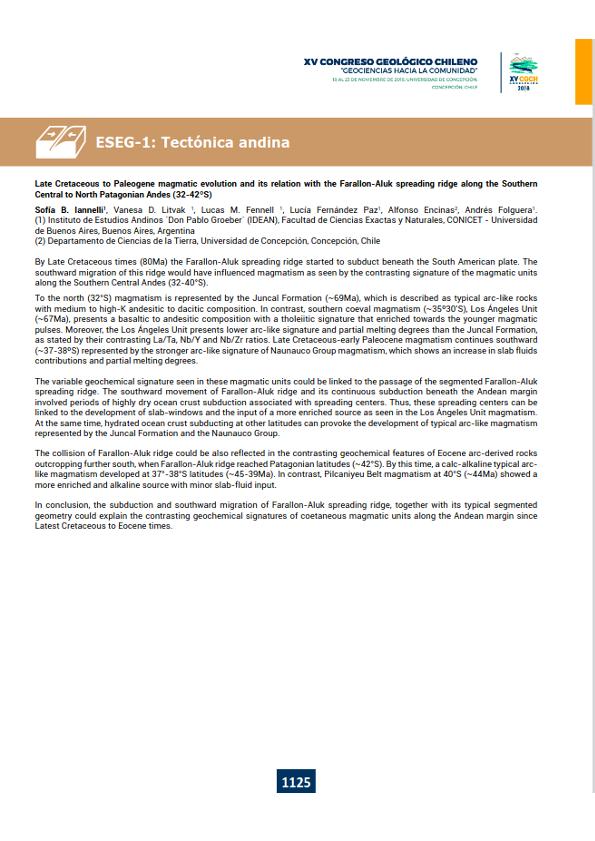Evento
Late Cretaceous to Paleogene magmatic evolution and its relation with the Farallon-Aluk spreading ridge along the Southern Central to North Patagonian Andes (32-42ºS)
Iannelli, Sofía ; Litvak, Vanesa Dafne
; Litvak, Vanesa Dafne ; Fennell, Lucas Martín
; Fennell, Lucas Martín ; Fernández Paz, Lucía
; Fernández Paz, Lucía ; Encinas, Alfonso; Folguera, Andrés
; Encinas, Alfonso; Folguera, Andrés
 ; Litvak, Vanesa Dafne
; Litvak, Vanesa Dafne ; Fennell, Lucas Martín
; Fennell, Lucas Martín ; Fernández Paz, Lucía
; Fernández Paz, Lucía ; Encinas, Alfonso; Folguera, Andrés
; Encinas, Alfonso; Folguera, Andrés
Tipo del evento:
Congreso
Nombre del evento:
XV Congreso Geológico Chileno
Fecha del evento:
18/11/2018
Institución Organizadora:
Universidad de Concepción;
Colegio de Geólogos de Chile;
Sociedad Geológica de Chile;
Título del Libro:
Actas del XV Congreso Geológico Chileno
Editorial:
Universidad de Concepción
Idioma:
Inglés
Clasificación temática:
Resumen
By Late Cretaceous times (80Ma) the Farallon-Aluk spreading ridge started to subduct beneath theSouth American plate. The southward migration of this ridge would have influenced magmatism asseen by the contrasting signature of the magmatic units along the Southern Central Andes (32-40°S).To the north (32°S) magmatism is represented by the Juncal Formation (~69Ma), which is described astypical arc-like rocks with medium to high-K andesitic to dacitic composition. In contrast, southerncoeval magmatism (~35º30?S), Los Ángeles Unit (~67Ma), presents a basaltic to andesitic compositionwith a tholeiitic signature that enriched towards the younger magmatic pulses. Moreover, the LosÁngeles Unit presents lower arc-like signature and partial melting degrees than the Juncal Formation,as stated by their contrasting La/Ta, Nb/Y and Nb/Zr ratios. Late Cretaceous-early Paleocenemagmatism continues southward (~37-38ºS) represented by the stronger arc-like signature ofNaunauco Group magmatism, which shows an increase in slab fluids contributions and partial meltingdegrees.The variable geochemical signature seen in these magmatic units could be linked to the passage of thesegmented Farallon-Aluk spreading ridge. The southward movement of Farallon-Aluk ridge and itscontinuous subduction beneath the Andean margin involved periods of highly dry ocean crustsubduction associated with spreading centers. Thus, these spreading centers can be linked to thedevelopment of slab-windows and the input of a more enriched source as seen in the Los Ángeles Unitmagmatism. At the same time, hydrated ocean crust subducting at other latitudes can provoke thedevelopment of typical arc-like magmatism represented by the Juncal Formation and the NaunaucoGroup.The collision of Farallon-Aluk ridge could be also reflected in the contrasting geochemical features ofEocene arc-derived rocks outcropping further south, when Farallon-Aluk ridge reached Patagonianlatitudes (~42°S). By this time, a calc-alkaline typical arc-like magmatism developed at 37°-38°Slatitudes (~45-39Ma). In contrast, Pilcaniyeu Belt magmatism at 40°S (~44Ma) showed a moreenriched and alkaline source with minor slab-fluid input.In conclusion the subduction and southward migration of Farallon-Aluk spreading ridge, together withits typical segmented geometry could explain the contrasting geochemical signatures of coetaneousmagmatic units along the Andean margin since Latest Cretaceous to Eocene times.
Palabras clave:
Cretaceous
,
Volcanism
,
Isotopic signature
,
Arc-like
Archivos asociados
Licencia
Identificadores
Colecciones
Eventos(IDEAN)
Eventos de INSTITUTO DE ESTUDIOS ANDINOS "DON PABLO GROEBER"
Eventos de INSTITUTO DE ESTUDIOS ANDINOS "DON PABLO GROEBER"
Citación
Late Cretaceous to Paleogene magmatic evolution and its relation with the Farallon-Aluk spreading ridge along the Southern Central to North Patagonian Andes (32-42ºS); XV Congreso Geológico Chileno; Concepción; Chile; 2018; 1125-1125
Compartir



